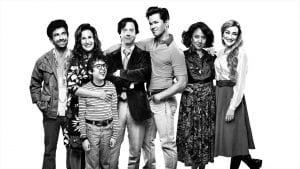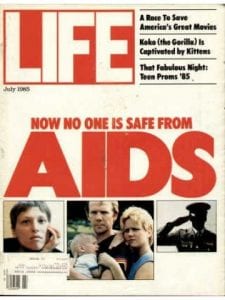By Tyler Blitz
The musical Falsettos was written and composed by William Finn and James Lapine. William Finn was born and raised in Natick, Massachusetts, and received his education at Williams College. He was openly gay, and survived major brain surgery in 1992, which is the year the play first appeared on broadway. The broadway musical was later nominated for seven Tony Awards, where it won Best Book of a Musical and Best Original Score. The play gained a lot of attention for its depiction of gay relationships and unconventional families amidst the HIV/AIDS crisis. In 1981 when March of the Falsettos was first performed, the disease now known as AIDS was still unnamed. When Falsettos, which was a combination of Act I and Act II, came out in 1992, perceptions of gay identity and of AIDS had progressed even further, for there were slight increases in medical advancements and more people living with HIV, however still much uncertainty.
Mainstream media suggested to the public that the AIDS disease is more than likely to spread from marginalized populations of gay men to the general heterosexual population. This information struck havoc among the general population and other media sources. For example, in 1985, amid the height of the scare, the cover of LIFE magazine, one that is very prevalent and popular to the population, made its title “Now No One Is Safe from AIDS”. People around the country began to fear the spread of AIDS, and started to blame gay men for this crisis, resulting in a significant increase of homophobia during this time period. The Human Rights Commission report cited “individuals going so far as to state that they see this disease as a punishment for the gay population” (Petro 24). This account proves the feeling of homophobia was rising among the general population due to this epidemic. Falsettos, which debuted only half a decade later, served as another form of media during this crisis. However, unlike the other forms, they tried to bring attention to the other side of the spectrum to show how tough it was for gay men to deal with it. At this point, gay representation was slowly becoming more prevalent in TV and film.
Amidst this time of minimal acceptance or care in regards the homosexual community, a cure to AIDS was not a priority, being that it impacted primarily the gay population. The prevalence of AIDS quickly began to skyrocket around this time, and it was becoming a huge problem in society, one that required at least some political support. However, the federal government, led by President Ronald Reagan at this time in the 1990s was markedly silent on the issue. No new federal programs designed to look further and research this new disease were launched. As the new diseases AIDS killed dozens, the federal government failed to react (Fetner 52). “The gay community’s challenge to attain the same standards of medical treatment, data collection, and research for AIDS patients as for people affiliated with other types of illnesses is connected to the activist, cultural, and community-building processes of gay men and lesbian throughout the decade” (Fetner 51). William Finn attempts to portray how AIDS impacted the gay community, in order to bring further recognition to this topic.
The following are accounts of cast members, and reasons why they chose to act in Falsettos and how much of an impact they believe it had on the LGBTQ society.
| According to Chip Zien, who played Mendel in Falsettos, “We are doing this show but it’s really important and we feel we’re the first people to really, really deal with it.” |
| According to Spencer Liff, the choreographer of the play who is an openly gay, felt that it was his responsibility to “present the show in a way that would make people stop and think about their actions, and have more respect for the battle” toward equality that LGBTQ people have had to fight across generations (Wong). |
| In addition, Andrew Rannells, who played Whizzer in the revival of Falsettos in 2016, said he is “happy that some young people will see the show and maybe learn a little bit about what that time was, because it was very scary” (Isherwood). |
In Falsettos, William Finn tried normalizing this situation by portraying what life was like for those types of families, and differentiated what life was like for them in comparison to the “traditional” Jewish family. While growing up in same sex marriage households was not generally accepted at the time, it has surely improved since then. According to American Religions and the Family, the beliefs have shifted dramatically since the opening of this play. Browning said, “While procreation and family are especially important as guarantors of the survival of the Jewish people, all Jews have a responsibility to raise and future the next generation of our people. The important of family, whether biologically or relationally based, remains the foundation of meaningful human existence” (Browning 160). This statement definitely elaborates upon the definition of a Jewish family to encompass all kinds of relationships, which is something that certainly has shifted since the 1990s, as well as the production of the musical.
One example of how William Finn attempted to portray the struggle of unconventional families in the gay community comes from the song My Father’s a Homo in Act I. In this scene, Jason says, “What about chromosomes? Do they carry? Will they carry?” It is clear that Jason is finding it difficult to fully understand his father’s homosexuality (Falsettos Act I). Jason is not aware at this point that homosexuality is not something that is entirely genetic. It is obvious that Jason is scared to end up like his father, based on his repetition of the word “carry” in the lyrics.
Additionally, in the song “Breaking Down”, Trina shows how her non-traditional family is collapsing and totally breaking down. She says, “The only thing that’s breaking up is my family”. This line shows the struggle that Trina is dealing with, and how having this difference in the household has impacted many families at the time.
Overall, Falsettos opened a door and brought light to the horrific AIDS epidemic taking place in the world, and contradicted the general traditional family composition. Today, the show is still important as hate and homophobia are more than prevalent in our society.
Works Cited
Fetner, Tina. How the Religious Right Shaped Lesbian and Gay Activism. NED – New edition ed., vol. 31, University of Minnesota Press, 2008. JSTOR, www.jstor.org/stable/10.5749/j.ctttvb8d.
Wong, C. M. (2016, December 29). Why Broadway’s ‘Falsettos’ Is A ‘Reality Check’ For LGBTQ Audiences. Retrieved from https://www.huffingtonpost.com/entry/broadway-falsettos-lgbtq_us_585bfb72e4b0d9a59457533b
Petro, A. M. (2015). After the wrath of God: AIDS, sexuality, and American religion. Oxford: Oxford University Press.
Peitzman, L. (2016, October 27). There’s Never Been A Better Time For “Falsettos”. Retrieved from https://www.buzzfeed.com/louispeitzman/falsettos-revival-is-the-timeliest-show-on-broadway
Browning, D., & Clairmont, D. (Eds.). (2007). American Religions and the Family: How Faith Traditions Cope with Modernization and Democracy. NEW YORK: Columbia University Press. Retrieved from http://www.jstor.org/stable/10.7312/brow13800
Isherwood, C. (2016, December 28). In ‘Falsettos,’ an Affecting Echo of AIDS Anxiety. Retrieved from https://www.nytimes.com/2016/12/28/theater/falsettos-memory.html


